Kevin Clarke
Operetta Research Center
8 Augustm 2020
Most operetta fans will know David Slattery-Christy as the biographer of Ivor Novello (1893-1951) and as a tireless champion of Novello’s oeuvre. He’s also the first Novello biographer who addressed the composer’s homosexuality openly and ask what it meant for his career in a deeply homophobic British society in the first half of the 20th century. Now, David Slattery-Christy has written a play entitled Ghost Lights about “Ivor Novello and His Leading Ladies,“ as the subtitle says. It will premiere in December 2020 as the finale of the London Song Festival, in a staging by the author. We spoke with Mr. Slattery-Christy about this project and the ongoing fascinating with Ivor Novello and his West End operettas which are too little known today outside of the UK.
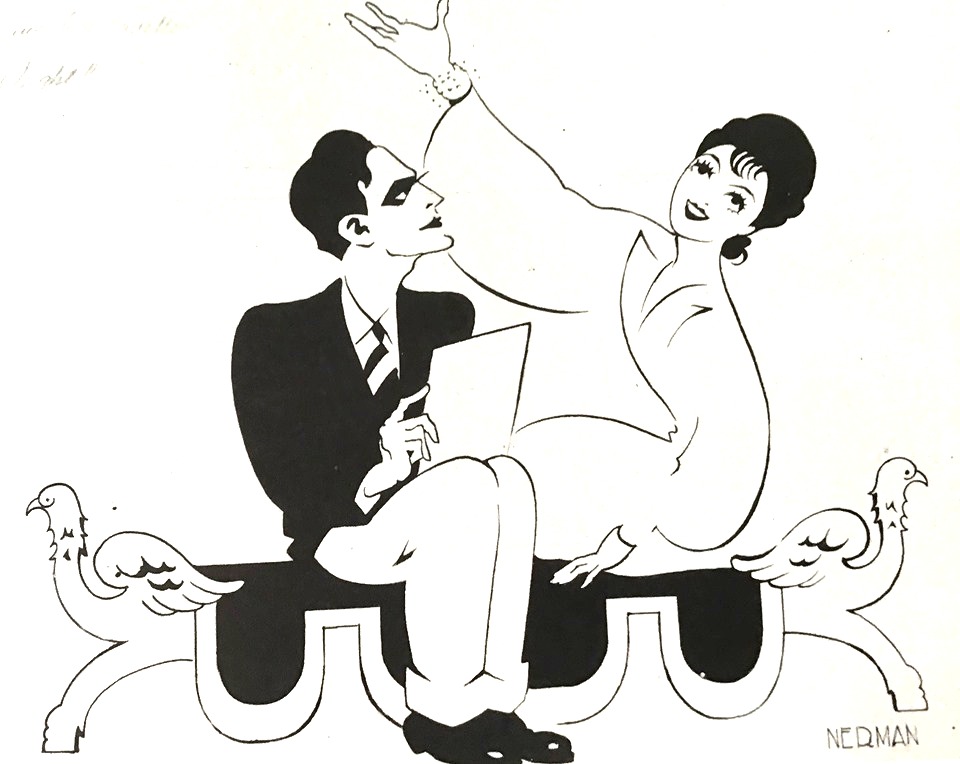
Mary Ellis with Ivor Novello in “Glamorous Night,” 1935. (Photo: Archive David Slattery-Christy)
Who are Novello’s ladies and what’s so special about them – as compared to Lehár’s leading ladies or Noel Coward’s female stars?
I was commissioned by the London Song Festival to write a musical finale that explored Ivor Novello’s famous Theater Royal Drury Lane operettas from 1935 to 1939: Glamorous Night (1935), Careless Rapture (1936), Crest Of The Wave (1936/7), and The Dancing Years (1939). Part of the commission was to incorporate the festival’s theme of ‘roads to solace’ into the work in regard to Novello and Coward’s hidden homsexuality (because it was illegal to be homosexual in the United Kingdom at the time), and thus there was the fact Novello and Coward as two very talented men created ‘solace’ for the masses whilst receiving none for themselves.
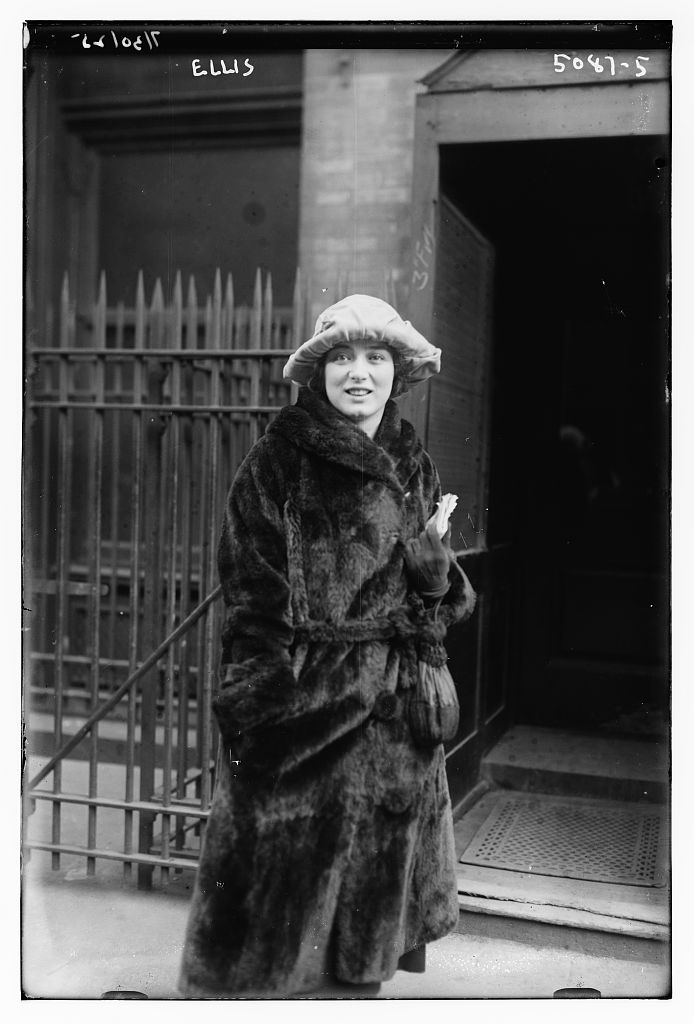
Mary Ellis at the stage door to the Metropolitan Opera in 1920. (Photo: Library of Congress)
Mary Ellis (who was the original Rose-Marie on Broadway) starred with Novello in Glamorous Night and The Dancing Years, and Elisabeth Welch also appeared in Glamorous Night, and Novello championed her career. Dorothy Dickson, a former Ziegfeld Girl, starred with Novello in Careless Rapture and Crest Of The Wave. Interestingly, they were all American and they were all very loyal to Novello rather than Coward.
Indeed Mary Ellis worked for Coward in his operetta After The Ball after the WW2, and they fell out in a spectacular way because Coward told Ellis her voice had gone and suggested it sounded like “someone f***ing the cat.” Ellis never sang in public again and it ended their friendship.
Elisabeth Welch was once asked by Coward why they had never worked together and she replied: “Just as well, that’s why we are still friends.”
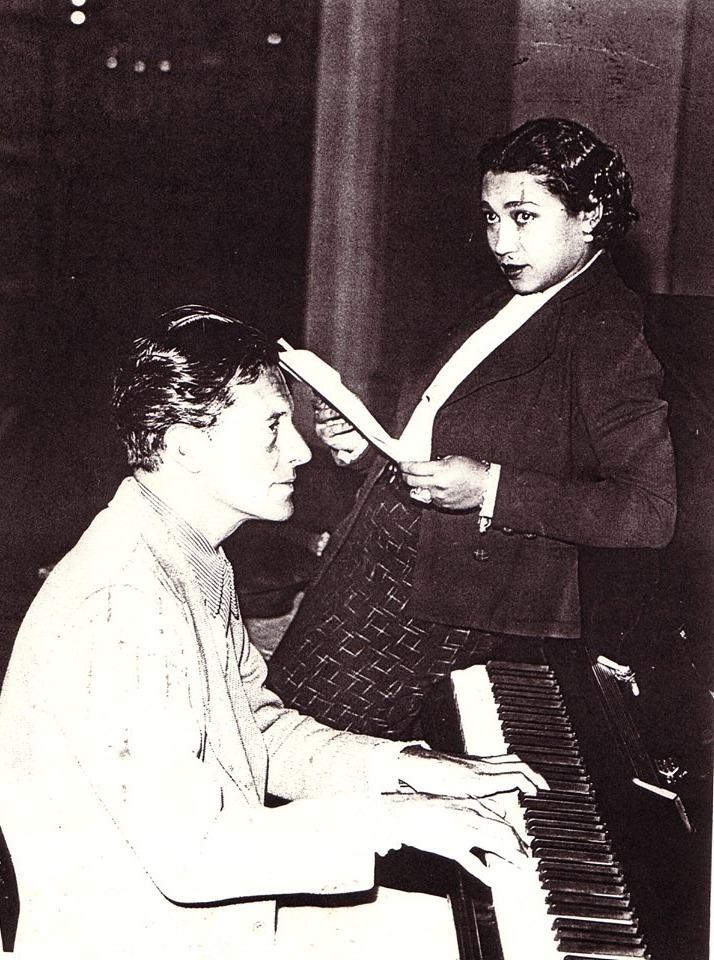
Elisabeth Welch rehearsing with Ivor Novello at the piano. (Photo: Archive David Slattery-Christy)
These women were worshipped by Novello because on stage he could be a man in love with a woman in a way he could never be off-stage. In a magazine article in the 1930s he said that “I have worked with all these beautiful leading ladies and still I am unmarried.” They created a cover for his homosexuality for the benefit of the public.
The title of your play is “Ghost Lights,” what does that refer to?
A theater ‘ghost light’ is the single bulb on stand that is placed on the stage when the theater is dark or closed. There is a superstition about always having a light on so the theater is never truly dark. The use of modern emergency lighting has seen the practice diminish in the United Kingdom, but in the USA theaters still have an actual ghost light used on the stage at night and when the theater is dark.
I decided to call the musical play Ghost Lights because in a way the characters of Novello, Mary Ellis, Elisabeth Welch, and Dorothy Dickson are theater ghosts of the past. With current theater closures I was reminded that in September 1939 theaters in the United Kingdom were closed due to the outbreak of World War 2, so it allowed me to build a bridge.

A scene from “The Dancing Years” with the soldiers arresting Rudi Kleber (Ivor Novello) wearing swastika arm bands. (Photo: Archive David Slattery-Christy)
Novello’s The Dancing Years was a victim of the 1939 closure, and theaters everywhere would have their ghost lights, including Drury Lane, on their stages. With that in mind I thought it interesting to create a link from the present to the past and have the four of them gather on the empty Drury Lane stage to reminisce about their triumphs and shows, and also discuss their fears about the future and if theater would survive. So people had the same fears about the future of theater as an industry then as they do now with the current closure.
Many of these historic leading ladies can be heard, today, on YouTube. If you compare their interpretations of Novello’s music with later singers such as Marilyn Hill Smith or Valerie Masterson how would you describe the difference?
Mary Ellis and Dorothy Dickson were of their time in their formal style of singing operetta, and Dorothy Dickson was more of a dancer than a singer anyway. Neither were helped by the recording techniques of the time that still struggled with some genres, and the result was hollow and tinny sounding vocals. Those later singers respected the material and toured in the shows, but they brought a depth and warmth to the vocals as well. Those early recording techniques were harsh and they failed to give an accurate impression of the vocals and made them sound thin and sometimes tinny. W. J. MacQueen-Pope, Novello’s publicist, recalled that seeing Mary Ellis command the stage at Drury Lane and sing was an extraordinary experience. She could be heard in the highest seats and there were no microphones in those days.
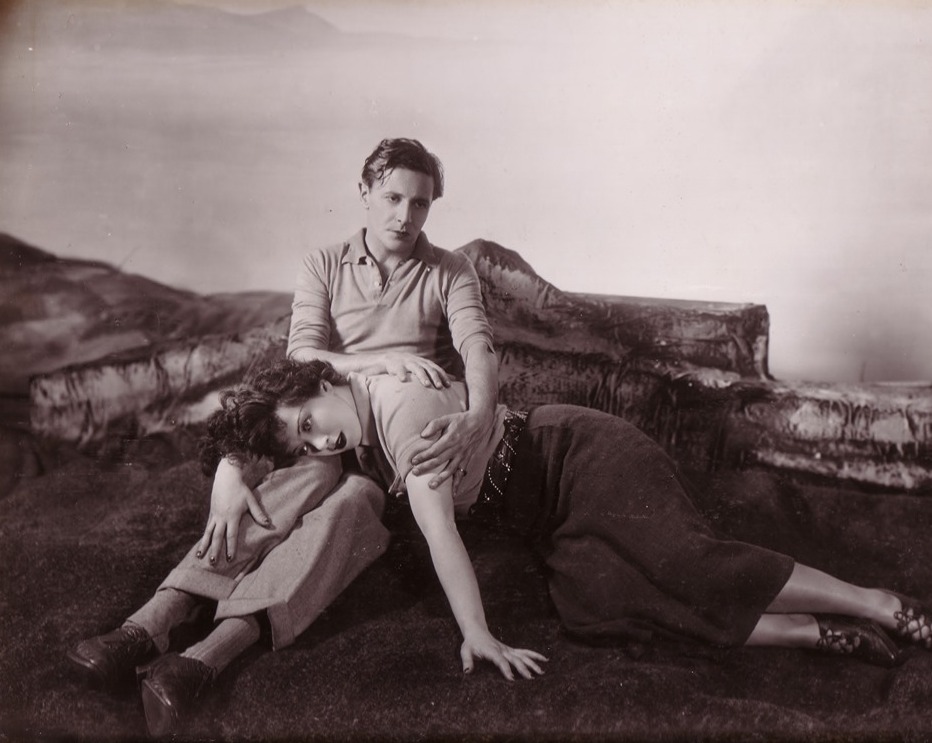
Mary Ellis laying with her head on Novello’s knee in “Glamorous Night,” 1935. (Photo: Archive David Slattery-Christy)
Elisabeth Welch was far more versatile in her jazz style, and having worked for the likes of Cole Porter in the USA she could connect with a much broader audience. Novello was determined to help her career.
Dorothy Dickson was a fun, glamorous actress/singer/dancer who was a perfect foil for Novello and had an energy of thousands that beamed over the footlights. She was a star in the glamorous Marlene Dietrich mold.
What is ideally needed, in your opinion, to make this music work and also make the operettas themselves take flight?
The London Song Festival was established in 2007 by Nigel Foster, who is our Musical Director and pianist for Ghost Lights, and his vision is the celebrate all types of music and song, or as he said himself “music and beauty and poetry and their emotional impact crosses all boundaries,” and with this piece I would add generations, too. It is rare that an occasion arises that can link the past and the present so beautifully and effectively as the current theater closures. These songs are just as relevant and important now as they ever were or as Nigel also said: “The London Song Festival’s message is that music and beauty and art can never die, and the aim is to show the relevance of song (whenever it was written) to 21st Century audiences.”
So for Ghost Lights the music I have embedded into the production not only develops the story for the characters but they will resonate with today’s audiences in a way that is unique to this moment in time but also shows that they are actually timeless. Novello’s music especially, in particular his more operatic style, can be rediscovered and re-imagined in ways that take nothing away from their original power. Novello is always going to be a romantic, and he loved operettas, indeed he was heavily influenced and inspired by Lehar’s operettas from the early 20th century, but his music strikes at your heart and his melodies so instantly memorable that as Elisabeth Welch said “you find yourself humming a tune whilst doing things and then realize it was one of Ivor’s.”
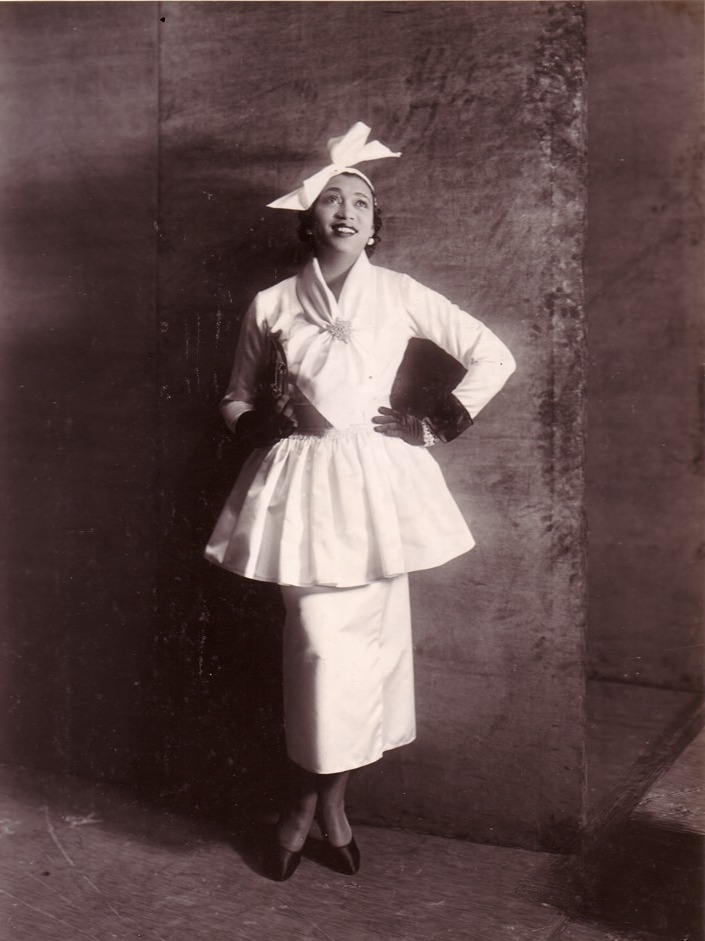
Elisabeth Welch in a formal portrait. (Photo: Archive David Slattery-Christy)
Your play is about the leading ladies that played opposite Novello himself as the leading man. He, too, can be heard on various YouTube clips with his distinct style. How would you describe that style, as compared to that of his great rival Noel Coward, and why is it rather modern?
His performance speaking voice was quite naturalistic compared to many stage actors of the time. He loved beauty and lived in a world of his own making. That world, and the people he invited into it, indulged him and allowed him to shield himself from the harsh reality that actually, because of his homosexuality, a world that did not embrace him or accept him. In a way the world he created for himself was his own “road to solace” and within it he played out his own fantasies of a life if he had been straight and could love women in a way he couldn’t in real life.
Coward on the other hand was much more of a realist in that as far as he was concerned if anyone didn’t like him then they and the world could go hang, and he would fend it off by being fabulous and witty and make himself loved and indispensible in that way. His style was also a way of dealing with his situation, and he proclaimed himself that he only had “a talent to amuse” so made the most of it.
Of course they were both living in a false reality because in spite of their efforts they were still unable to be who they truly were and live openly as gay men. Women loved Novello because of his romanticism, and this could explain why they refused to accept or think about his real sexuality – he was a fantasy that tempered the reality of their own husbands or lack of romantic life. This made him untouchable in their eyes, and they would flock to see him in theaters perfect and untouchable on the other side of the footlights.
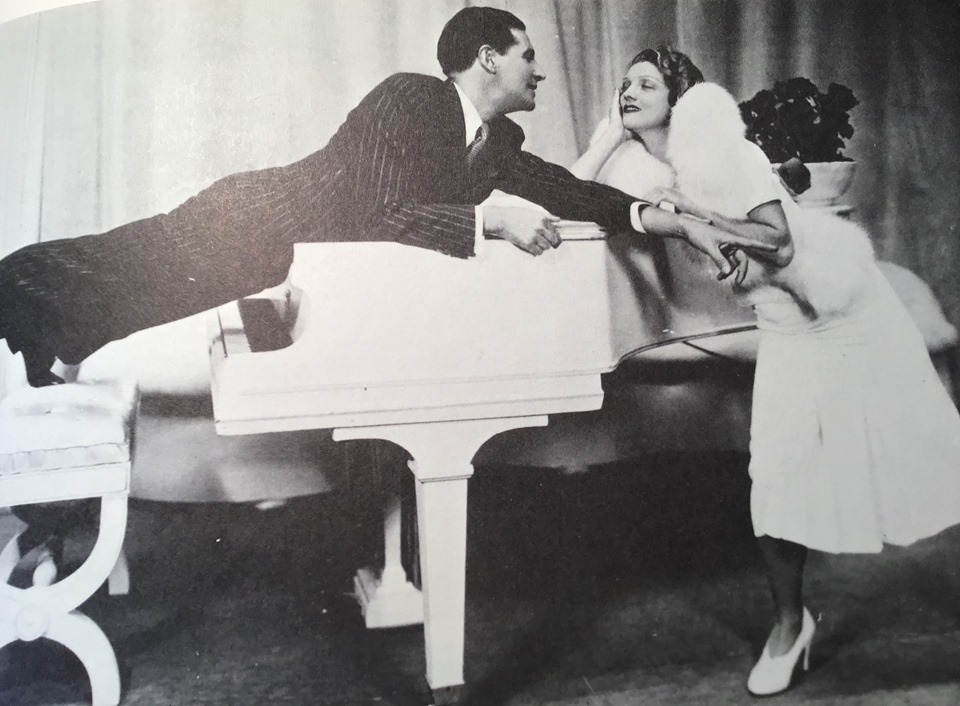
Ivor Novello with his leading lady Dorothy Dickson. (Photo: Archive David Slattery-Christy)
Is there anything in Novello’s “masquerade” that could interest a younger generation of queer activists and is it historically important and worth examining further?
Perhaps those today who live in a more accepting world with equal rights in terms of their homosexuality can learn a lot from Novello’s and Coward’s respective lives, and also be thankful for people like them because in their way they blazed a trail for the freedoms that are taken for granted today. With Novello I feel his sexuality was an important factor in his ability to create the way he did and to compose the music he did. Because he had to create a fantasy life for himself on stage to satisfy his need to be successful and fit in that in itself influenced his music – and to project an accepted ‘normality’ to the wider world.
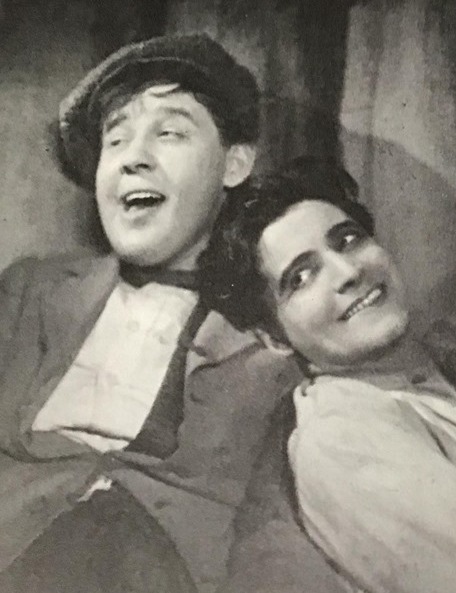
Ivor Novello in “Liliom” in 1926, a West End staging with Charles Laughton as his partner; another famous closeted actor. The famous Molnar play was later turned into the musical “Carousel” by Rodgers & Hammerstein. (Photo: Archive David Slattery-Christy)
I always feel with Novello’s music that there is a real sadness and yearning, melancholy even, in its structure that can at times be heartbreaking. Had he been a straight man I doubt if his work would have been so powerful and moving and his audiences, especially the women, would have become disenchanted with him if he had had many women and married. It would have broken the perfect illusion for them. As for Coward it was a different story – he made them laugh and his outspoken witticisms were shocking, but entertaining, and often things many wished they had the confidence to say themselves with such eloquence. They didn’t care who he slept with.
There has been quite a bang with regard to operetta in Germany in the past 10 years, particularly in Berlin. Would Novello’s shows benefit from such a revolution and do you see any signs in the UK for such a “big bang” comparable to Barrie Kosky’s work?
The time has to be right for any renaissance, and with Novello I feel that there should be more exploration and discussion around his most famous operettas. Glamorous Night (1935) was really influenced by Lehar’s The Merry Widow, and also The Prisoner of Zenda. It also has links to the more modern rock opera Evita in some aspects of the story. It is about a strong woman who rules and who everyone adores (Militza Hajos), and she is a “gypsy” by birth and so an outsider whom the establishment and government hates. It’s age old, isn’t it? The Dancing Years (1939) was a first in that Novello attempted to deal with the rise of Nazi Germany as it was happening, unlike Cabaret that is retrospective, but he was thwarted by the theater censor at the time because the UK government didn’t want to cause offence in Berlin or rock the boat. (To read more about this, click here.)
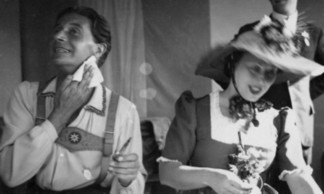
Ivor Novello wiping off the make-up after a performance of “The Dancing Years.” (Photo: Archive David Slattery-Christy)
But the theme is about a composer who has his work destroyed and is imprisoned for being who he is (Jewish) but it doesn’t take much thought to see that Novello could see the parallels with his own life and the risk he could be imprisoned and ruined professionally for being gay. Everything changes and nothing ever stays the same, so perhaps the time for a real renaissance will arrive sooner than we think. After all, who would have thought a year ago that all the musicals that have dominated for 30 years would have to close, and nobody knows if they will ever reopen. It is a strange world, and strange times, but one thing is for sure: arts and music and song and the theater will always survive and evolve. Novello deserves the ‘big bang’ revival treatment above anyone.
Who’s your own favorite leading lady?
That is a tough one. Of the three leading ladies portrayed in Ghost Lights I was lucky to have met two in person, Mary Ellis and Elisabeth Welch. Dorothy Dickson, who lived until the age of 102, I didn’t meet but sense from what I know about her that she was great fun and was very close to Novello like a naughty sister. He loved to have fun and be naughty.
Mary Ellis was much more serious and restrained and didn’t find it easy to let go, or be at ease with people generally. She was found to be aloof and unfriendly by the cast of shows, but I think this was insecurity more than arrogance. She had a facade that was almost impenetrable, and she carried that with her until her death at 105. She argued ferociously with Novello, and he gave back as good as she gave, but through it all they remained friends.
She once said to me that “You will never find an Ivor personality” with such wistfulness, and with a brightness in her eyes, that I realized that she still loved the memory of him and the life they had known working together.
Elisabeth Welch is the one that I admire the most as she was the one who had to work harder than any of them for the recognition and stardom she won. She was also able to observe and not become too entangled in the world of Novello – appearing like a bright comet as it flashed across the sky with her performances and she never upstaged anyone, or them her, and you never forgot the power of her presence and performances. She carried that with her for life and died aged 98. I feel so lucky to have crossed their paths and they were my link to that past where they were big, big stars of the theater.
Would Ghost Lights make for a TV series or movie? Isn’t a Netflix series “the new normal,” celebrating LGBTIQ and diversity? Who could be in such a Netflix-Novello production? Would it bring the composer/actor to the attention of a much wider audience? Have you spoke with Ryan Murphy yet?
I was commissioned to create Ghost Lights for the London Song Festival finale performance on Friday 11th December this year for their ‘Roads to Solace’ season. It is hoped that socially distanced audience will be allowed and the performance will be live streamed by Arts Digital. Should the worst happen and there can be no audience the plan is to live stream anyway so people can log in and watch from their homes. Details can be found at www.londonsongfestival.org. That is the first stage of this new musical play, and if successful it will be developed further. We have some brilliant contemporary performers to portray these iconic women. Rosemary Ashe will play Dorothy Dickson; Melanie La Barrie will play Elisabeth Welch and Rebecca Louise Dale will play Mary Ellis. At the time of writing we have not confirmed our Ivor Novello, but details will be on the London Song Festival website.
There is certainly a lot of potential to bring Novello and his life and work to the screen and you never say never with these things. I’m a great fan of Ryan Murphy, especially his Bette & Joan and Hollywood series. He does create fantastical versions of the world these characters lived in, and this kind of treatment would work exceptionally well for Novello in the 1920 through to his death in 1951.
There are rich seams of storyline waiting to be developed from his musicals, his love affairs and also his secret gay life and parties, his prison sentence in WW2, and also mystery, too. It has always fascinated me that the night Novello died at his flat above the Strand Theater in London’s West End (now the Novello Theater) that the first thing his partner Bobbie Andrews did was hurriedly travel to their country house Redroofs. In the middle of the night he then built a bonfire in the garden and started burning things. Why did he do that? What did he have to destroy so quickly?
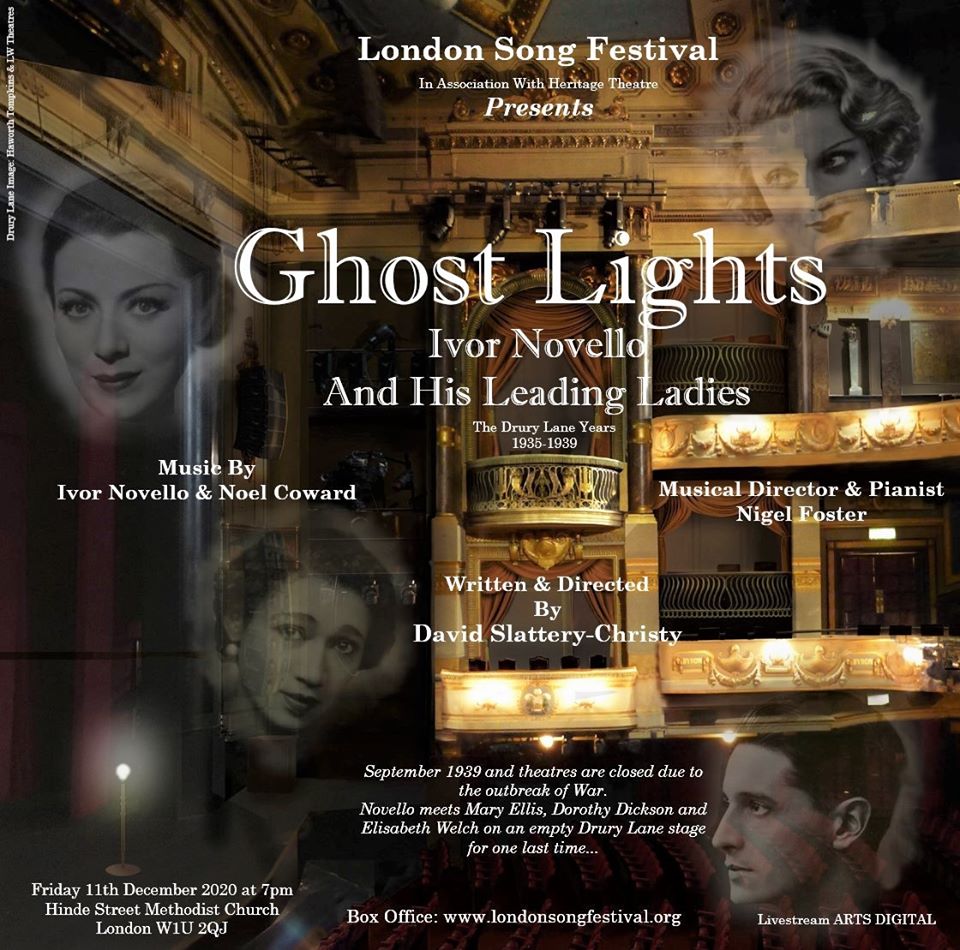
Poster for the 2020 production of “Ghost Lights.”
You can only wonder what secrets were lost forever that night. As well as British Theater stars many Hollywood stars like Joan Crawford, Douglas Fairbanks, Greta Garbo, Cary Grant, Tyrone Power all befriended him and stayed at Novello’s country house Redroofs, so there are lots of links to make any drama appealing on both sides of the Atlantic. I am always happy to have the conversation and there would be lots and lots to talk about and so much potential!
To read more about the operettas of Noël Coward and Ivor Novello in an essay by Richard C. Norton, click here.
